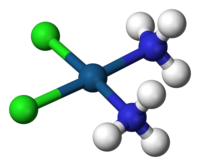
Photo from wikipedia
Abstract As we all know, the Cu complexes have been extensively studied as synthetic models because of their different valences. Here, the organic ligand of 1-methyl-1H-benzo[d]imidazol-2-yl)methanol (HL) was used to… Click to show full abstract
Abstract As we all know, the Cu complexes have been extensively studied as synthetic models because of their different valences. Here, the organic ligand of 1-methyl-1H-benzo[d]imidazol-2-yl)methanol (HL) was used to react with Cu(ClO4)2·6H2O in CH3CN, we successfully obtained a mix valent copper complex [CuII(L1)2][CuI(HL)2]·ClO4 (1) under 60 °C. The structure analysis suggested that the Cu1 ion was coordinated with two nitrogen atoms from two HL ligands, which two ligands without removing H ions. The Cu2 ion was coordinated with two oxygen ions and two nitrogen atoms from two L1 ligands, which two ligands with removing H ions. The X-ray photoelectron spectroscopy (XPS) test showed that the valence state of Cu1 ion was +1, and the Cu2 ion was +2. The magnetic susceptibility was exhibited ferrimagnetism with g = 2.04. The electrocatalytic results suggested that CuIICuI species reacted with O2 to give a superoxide radical intermediate for complex 1.
Journal Title: Inorganica Chimica Acta
Year Published: 2021
Link to full text (if available)
Share on Social Media: Sign Up to like & get
recommendations!